Trunk fusions are a grafting technique that use multiple approach grafts of seedlings or rooted cuttings to create a large base trunk with a dramatic even taper in a relatively short time frame.
The traditional way to grow a trunk quickly is to plant a tree in the ground to grow and then chop the trunk repeatedly for several years. This method, while quick, leaves massive scars and a disfigured trunk. Trunk fusions are not a traditional ‘old school’ method for growing a Bonsai trunk. This is probably not a technique that a Bonsai master like John Naka would use. Or would he?
In 1982 Naka published his second book Bonsai Techniques II. In this book Naka shows photographs of a small honeysuckle tree and describes how it was created “Several honeysuckle vines were fused together to form this entwined trunk KARAME-MIKI. Multiple trunks growing together and growing as one”. He shows a drawing of “vines wrapped around an interesting branch, after several years the branch inside will rot away and eventually the vines will fuse together”. This is the basic concept of trunk fusions, however today we now use wire frames instead of interesting branches and tree seedlings or rooted cuttings instead on vines.
There are several advantages and disadvantages to using the trunk fusion technique:
Advantages
- Control of the tree design. We can plan the size, taper and style of our tree from the earliest stages. A significant advantage if you know what you want to create.
No trunk chops. If there is one thing that can ruin the appearance of a tree it is an ugly scar from a trunk chop. Fusing seedlings will leave many scars where the excess seedling is removed but the scars will be small and heal quickly. - Great nebari. All those tiny little roots from the seedlings add up to several hundred small roots for the fused trunk creating an incredible nebari.
- Speed. If the tree is assembled and cared for correctly fusion of the trunk can be completed in a few years on some aggressive tree species.
Disadvantages
- Dead seedlings don’t fuse. We are growing 50 to 100 trees until the fusion is complete. Dead seedlings will leave gaps in the trunk that will lengthen the fusion time. We need to set aside a few seedlings to fill these gaps.
- Genetic variation. Some seedlings may have different characteristics than the parent tree and this can cause leaves to appear differently on a fused trunk. This can be avoided by using rooted cuttings, which are an exact clone of the parent tree.
- Sibling rivalry. Seedlings planted side by side will have to compete for limited resources of light, water, nutrients and space. Some seedlings will dominate and some will die off or have slower growth.
- Speed. Speed is an advantage but can be a big disadvantage if assembly is poor or proper care of the tree is neglected.
How to create a fused Bonsai trunk
Approach grafts are most commonly used to add a branch to a tree by simply securing the two together. As they grow and swell the pressure of being firmly secured together forces the two pieces to fuse into one. After fusion is complete the donor is removed below the graft.
A multiple approach graft involves securing seedlings side by side by side to form a trunk. Usually 50 to 100 seedlings are used. Again the pressure of being firmly secured together forces the seedlings to fuse. Without this pressure the seedlings would simple push each other around and would never fuse.
Three materials are necessary to assemble a trunk fusion project:
- Seedlings or rooted cuttings. One-year-old material that has developed a good root mass to support the seedling is best.
- A frame made of wire. The best choice is hardware cloth or chicken wire can be substituted.
- Paper wrapped twist ties. Since they will be left in place and never removed it is important to use only paper wrapped twist ties. The paper will dry and flake off while the wire will become embedded permanently in the tree.
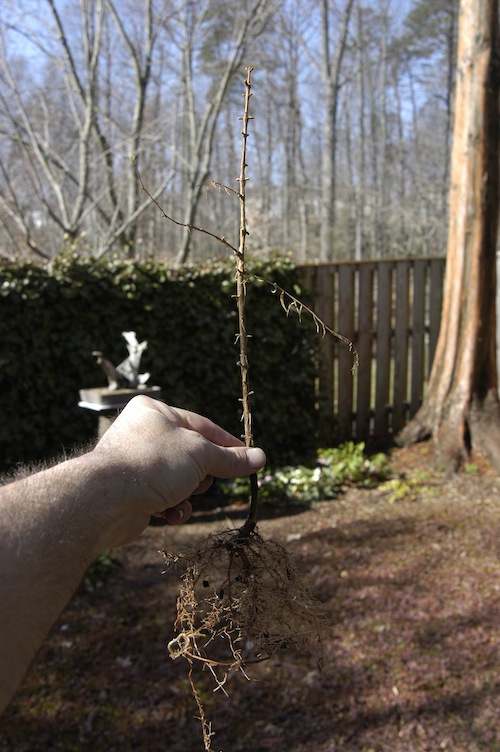
Example of a barerooted seedling.
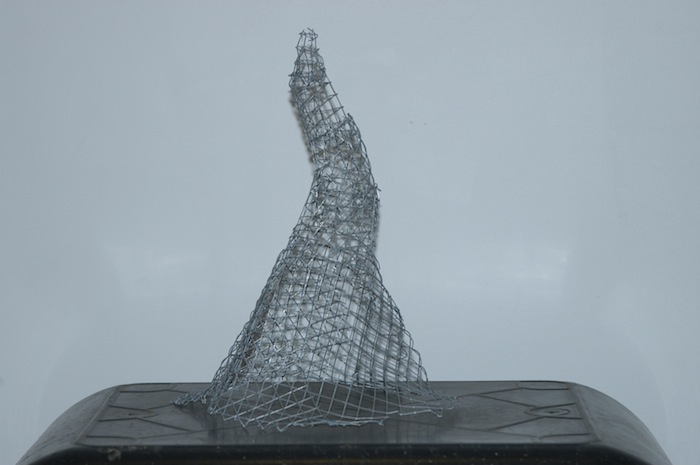
Wire frame used for the trunk fusion.
When to start?
The best time to begin a project is in early spring just before seedlings break their dormancy. Seedlings are bare rooted and placed in a bucket of water to keep from drying out. Do not trim the seedling or roots. 2 or 3 of the tallest seedlings are spaced evenly and tied to the bottom of the frame and then are tied to each other at the top of the frame to create an apex. Additional seedlings are added by splitting the difference between the seedlings at the bottom of the frame and the established apex. Keep splitting the difference until there are no gaps left. The tree is immediately planted in the ground before the roots can dry out.
A few tips for assembly and care of the tree(s)
- Do not let the roots dry out. Either constantly mist the roots or assemble the tree in a large pan with the roots submerged in water.
- Have the frame completed before you bare root the seedlings.
- Attach the seedlings as close as possible so you don’t have gaps. Gaps will only extend the time needed for fusion to occur.
- Girdling will occur where the seedlings are attached with the twist tie. This is good because this swelling forces the seedlings to fuse. The bumps will soon disappear.
- You cannot use too many twist ties. Fusion begins first at the point of connection and then spreads up and down between connections.
- Do not trim excess seedlings as they exit the trunk. These whips should be allowed to grow freely to help thicken the seedlings.
- Planting the tree(s) in the ground will give the roots room to spread out and lesson competition among the seedlings.
- Do not remove the twist ties. The fusion will separate. Excess twisted wire can be cut off a year after fusion has occurred.
- Do not use plastic wrapped twist ties.
- Resist the temptation to do anything to the tree the first year other than water and fertilize.
- Have a few seedlings in reserve to replace any dead seedlings after the first year.
- This project will take one person 3 to 4 hours to complete a 50-seedling Bonsai fusion project. Expect additional time if this is your first project or find a partner to help.
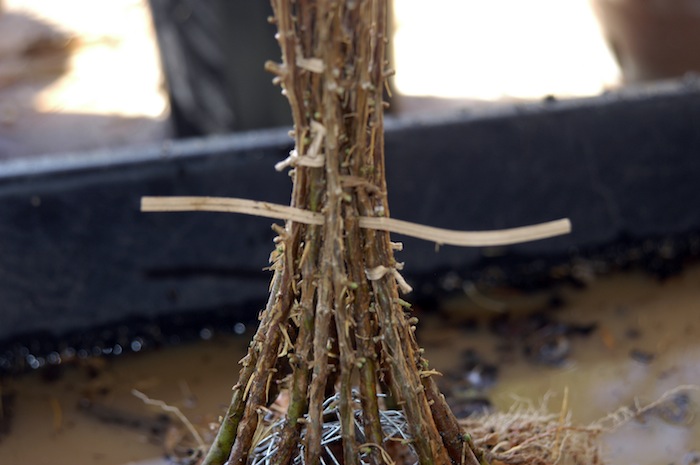
Attaching the seedlings.
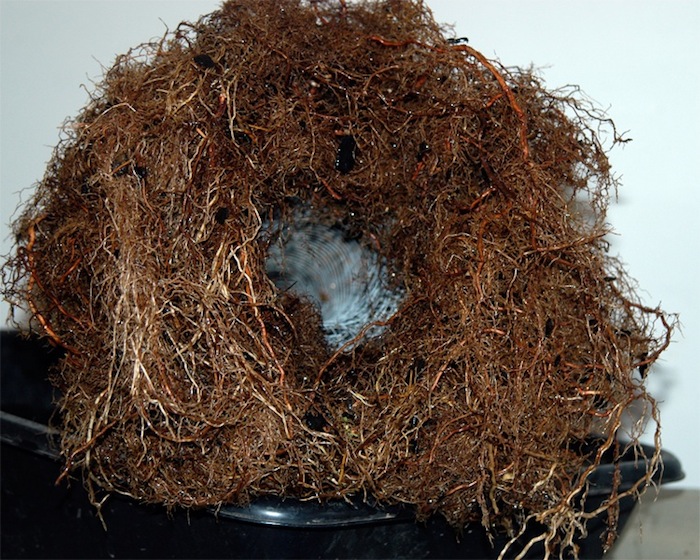
The roots, seen from below.
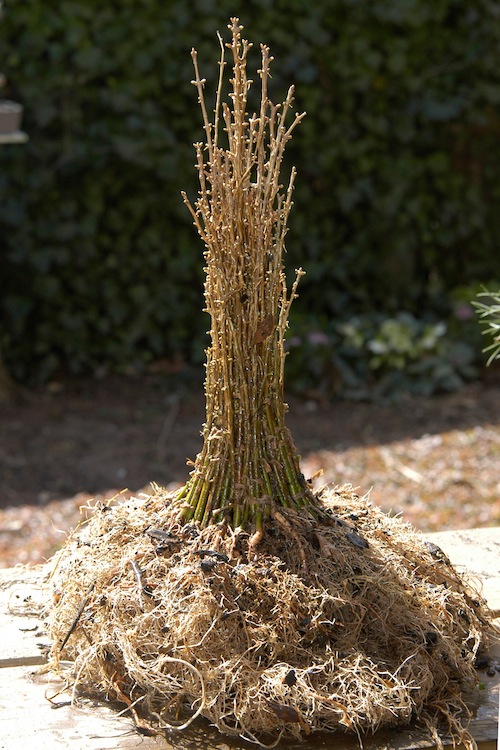
The assembly for Bonsai trunk fusion is completed.
Written by: Greg Wentzel (fusionbonsai.com). “Greg Wentzel lives with his wife Michelle in Virginia, USA. He is a member of the Northern Virginia Bonsai Society and has studied under his uncle and Sensei Peter Jones. Greg has written articles for Conifer Quarterly and Golden Statements”.


